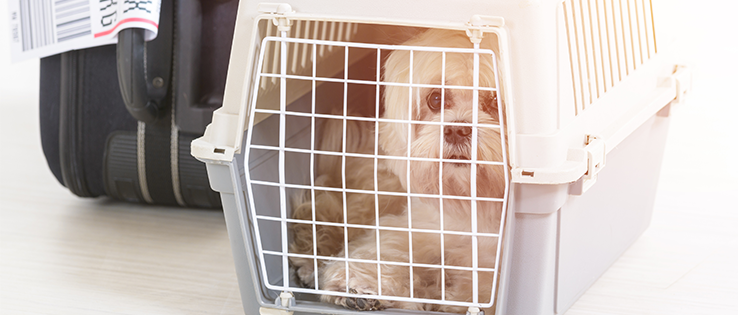
In my job, I get to travel a lot. Ideally, whenever and wherever I can bring my dogs with me, I do. Planes, trains and automobiles, are the most common methods of transport for me, which brings me to today’s topic; flying with your pet. I have flown Chester my Staffordshire Bull Terrier several times, when I am working interstate. Sometimes it has been because his expertise are just as valuable as mine, or because I am away from home for a prolonged time.
Flying your pet can be stressful for both of you. There are many things you should consider before flying your pet, particularly, what type of animal you have, and your reason in flying them in the first place. Many people will have a puppy flown interstate, whilst others may be relocating to another country with their pet. There are various reasons for flying your beloved furry friends, but it is important that your reasons in doing so, are in their best interests too.
Whether domestic or international travel, there are some essential guidelines I encourage you to follow. When you are prepared and organised, the flight and days of travel will be far less stressful for your pet. Disorganised traveling can be very alarming for dogs in particular, as the predictability and controllability of their environment ceases to exist. Dogs are creatures of habit, so maintaining some elements of their habitual lifestyle is very helpful.
If you are traveling internationally, you will need to prepare documentation, sometimes even months prior to your flight. Additionally, many countries outside of Australia will require a period of quarantine, and most countries your pet visits will almost invariably require them to be in quarantine in Australia too. This can be a difficult time for both you and your pet. If you have planned your travels well however, the period of time you will be separated, can be as little as 10 days.
Your pet must be contained at all times in transit. This is for their safety. It is worthwhile purchasing a crate (airline approved) or at least hiring one well before you travel, so that you can train your pet to use it as a safe place. I spent two weeks training Chester to utilise his crate as a sleeping hut, which he loved. When it was time for him to travel in the crate, it was far less stressful for him. It is strongly recommended against sedating your pet, because it can reduce their blood pressure and cause dehydration. Additionally, in times of turbulence, your pet may not be able to balance as well as they might if they were completely alert.
The breed of your dog is also very important to consider, as is the climate when traveling. Temperatures over the high 20’s would be a cause of concern in my opinion. Additionally dogs who are brachycephalic (short snouts such as bull dogs) can suffer overheating in high temperatures. I would strongly advise against flying a breed like this, particularly in higher temperatures.
Your pet is not supervised during the flight, but is provided with water during transit. The crew and pilot are aware that there are live animals on their planes, so your pet’s cabin is air pressurised and air conditioned. I never feed my dogs before traveling, as it can cause nausea and distress. As soon as the plane lands, your pet should be the ground crew’s first priority, so you are able to collect them in domestic transit within an hour. It is important to try and not fuss over them, when you meet them at your destination. Be calm and provide an energy that helps them recover from any anxiety as quickly as possible. They will probably want to go to the toilet, so most collection points are grassed and accessible.
For me, it is so important that my pets feel safe and cared for. Sometimes, this means that they stay home with a loving pet sitter, whilst I work for a week or two. Particularly with puppies, it is imperative that their critical period of development is not hindered with a negative travel experience. Ideally, all traveling for pets would be stress free, however, in reality, it rarely is. This is once again because most of the control and predictability is taken from them.
Whilst some stress may inevitable, there is no reason why you cannot make the experience as positive and comfortable as humanly possible. Here’s how:
- Provide familiar and calming scents in the crate
- Pre-train your pet to use the crate comfortably at home first
- Be calm and positive
- Be organised with your paper work
- Have water and poo bags with you for drop off and pick up (some airports have toilet points inside)
- Avoid traveling by plane if it is not necessary
- Avoid sedating your pet (sedating yourself might be a different story)
- Ensure your pet is microchipped and has their correct identification on the crate
- Ensure your contact details are up-to-date and correct
Bon Voyage and enjoy seeing your pet explore their new surrounds. Look for the signs of stress and work to alleviate these by being prepared and calm. If at any point you are not convinced your pet is comfortable enough to travel, let an airline staff member know. They are always very supportive and caring of your pet’s needs. In the meantime, can we campaign for our dogs to be in the cabin with us? I wonder which airline we should contact first. Any ideas?